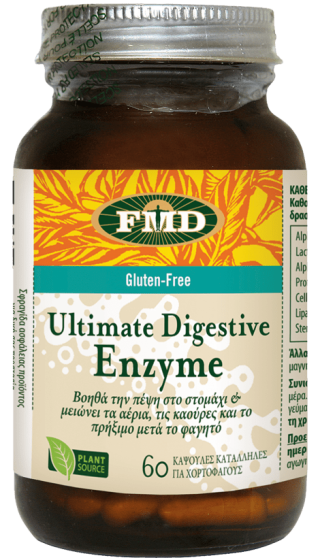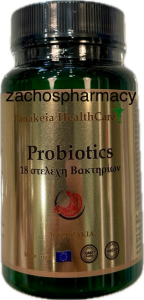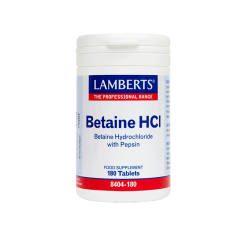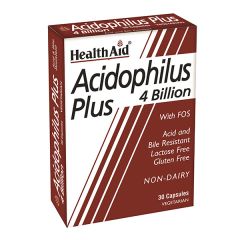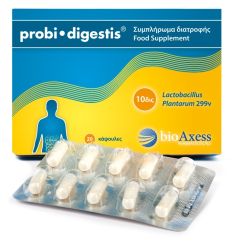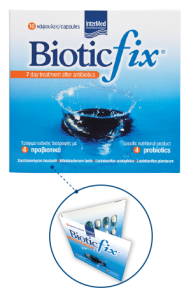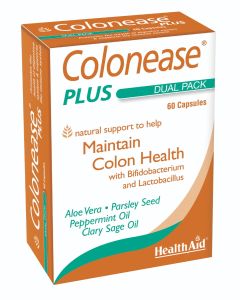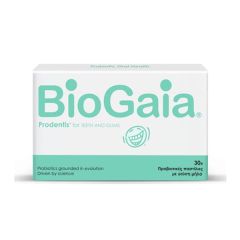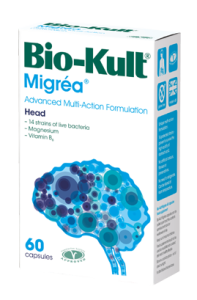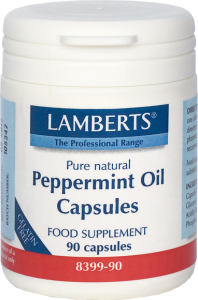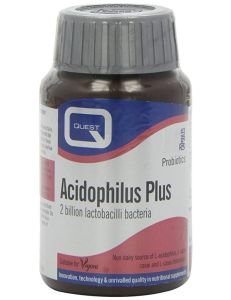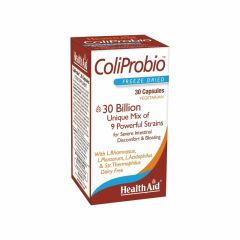Udo's Choice Ultimate Digestive Enzyme 60.veg.caps - Specialized formula of 7 active enzymes
Special Price
€30.18
Regular Price
€35.50
In stock
SKU
8938
Udo's Choice Ultimate Digestive Enzyme 60.veg.caps - Specialized formula of 7 active enzymes
Flora Udo's Choice Digestive enzyme
Flora Udo's Choice Digestive enzyme
Specialized formula of 7 active enzymes, designed to ensure proper digestion.
They improve the absorption of nutrients, increase energy levels, reduce irritation and food allergies and maintain the health of the digestive system. Especially helpful for those whose diet is rich in protein and fiber.
For better digestion of all foods.
A powerful complete range of 7 active enzymes, from 100% plant sources that supplement the natural enzymes lost during cooking.
It contains enzymes that break down proteins, fats, carbohydrates, fiber, starch, lactose and complex sugars - along the entire digestive tract.
Helps reduce all gastrointestinal symptoms such as gas, bloating, acid reflux or constipation, constipation or diarrhea.
Helps maximize the absorption of nutrients available through food, which leads to increased energy levels.
It has guaranteed activity and is expressed in the internationally accepted FCC activity units.
Gluten Free - Vegetarian Friendly - Not Genetically Modified
Health Canada Approved Health Claim: Helps reduce the side effects of incomplete digestion of food.
Many people recognize that they feel better as soon as they get a digestive enzyme at every meal. Facilitates digestion, reduces fatigue, bloating and malaise that often follow after eating. The Ultimate Digestive Enzyme achieves the complete absorption of our daily food, regardless of dietary choices. Ideal for everyone.
What are digestive enzymes?
Enzymes are large molecules of protein, found in every living organism and act to:
convert food into energy
support the building of new cells
control the metabolic process
accelerate biochemical organic reactions
There are 2 main types of enzymes involved in the process of digestion acting as catalysts:
Digestive enzymes are like scissors that cut the food we eat into basic building blocks, which are then absorbed by our body and used to create cells, tissues, organs, glands and generally all organic systems. They are produced endogenously by the pancreas, stomach and salivary glands.
Food enzymes are found in raw foods which, when not eaten fresh, are decomposed, that is, they literally "eat" themselves.
What is digestion?
Digestion is the process of breaking down food into basic nutritional building blocks, which are absorbed through the bloodstream and used for the multiple functional needs of the body. Ideally, digestion is supported by a combination of digestive and food enzymes.
It starts in the mouth with the enzymes in saliva breaking down starch and sugars.
In the stomach, hydrochloric acid acts on proteins, while food enzymes continue to break down food into smaller pieces and then into the alkaline environment of the small intestine, rich in pancreatic enzymes, until the nutrients are ready for absorption by the circulation. of blood.
Inadequate chewing does not allow saliva enzymes to act before food is delivered to the stomach. Raw foods should be adequately chewed, as cellulose is hard and the pancreas does not secrete the cellulase that breaks down cellulose. So liquid foods must stay in the oral cavity long enough for saliva enzymes to break down starch and sugars, while solid foods must be chewed until they become fluid. The food should be chewed about 30-50 times before swallowing, until it becomes liquid.
The consequences of a lack of an enzyme
Enzymes are sensitive to heat. Cooking can destroy 100% of the natural enzymes found in food. The absence of natural enzymes in the modern diet, leads the pancreas, which is normally destined to secrete as many enzymes as needed to finish the work that began in the mouth and stomach, to overwork. Eventually, it may not be able to meet the increased demands on enzyme production, thus allowing partially broken down foods to enter the bloodstream. The body does not recognize these poorly broken down foods (mainly proteins) as nutrients and, considering it under attack, activates the immune system in the form of an allergic or inflammatory reaction. The immune system starts the process of producing antibodies against the food (which should be a friendly visitor) instead of doing its job of treating and healing wounds and fighting viruses, bacteria and fungi.
Dietary supplementation of digestive enzymes with Ultimate Digestive Enzyme supports proper digestion, improves nutritional absorption, increases energy levels and reduces the appearance of gas, bloating, food allergies and intolerances.
How can Ultimate Digestive Enzyme help?
Ensures maximum absorption of nutrients from foods and other supplements
Allows the pancreas to rest, refresh and return to normal function
Our energy levels increase because more nutrients are available in the cells
Supports a healthy digestive system, relieving it of the symptoms of incomplete digestion
Why do I need a mixture of enzymes?
There is no single enzyme or enzyme formula that is suitable for everyone. This is because our eating habits and lifestyle, as well as the capabilities of our digestive system, change with time and the different conditions in our lives.
Many people choose a selective diet for a variety of health reasons. Low-carb, high-carbohydrate, vegetarian, macrobiotic, raw and even detoxifying or antifungal diets are all specialized, prohibitive for many important food groups and often unbalanced.
In contrast, there are many people who eat erratically and carelessly with processed foods, which provide the body with very low value meals, rich in protein, refined carbohydrates and destructive fats. Finally, many people find that even if their diet is quite healthy and balanced, they feel really better when they consume digestive enzymes with every meal. The Ultimate Digestive Enzyme helps the digestive system absorb the right nutrients and eliminates the symptoms of incomplete digestion.
What should one expect?
You may notice an increase in the frequency of bowel movements as soon as you start taking the Ultimate Digestive Enzyme. This is a good sign that the digestive process has already become more efficient and bowel motility more efficient. After a few days, you may notice that you pass less stool because more food is broken down and nutrients are used by the body.
Many people also notice that, as soon as they begin to achieve better absorption of nutrients, they are satisfied with less food, resulting in reduced hunger and gluttony. Conversely, others, who are underweight due to poor absorption of nutrients, recognize that their digestive enzymes help them utilize the nutritional value of food, allowing their body to better maintain and grow without losing weight.
The enzymes in Ultimate Digestive Enzyme are 100% plant-based. They come from plants and fungal crops.
The selection of the 7 active enzymes has been done so that each enzyme contributes to the breakdown of different food groups. Each enzyme operates within a specific pH range. Some aid digestion in the acidic environment of the upper and lower digestive tract, while others may be active only in specific areas of the alkaline environment of the small intestine:
Alpha-amylase: Decomposes food starch into simple sugars
Lactase: It breaks down lactose and helps digest dairy products
Alpha-galactosidase: Hydrolyzes refined carbohydrates
Protease: Strong fibrinolytic and anti-inflammatory action
Cellulase: Converts cellulose into glucose, reduces fiber volume
Lipase / Triacylglycerol lipase: Digests triglycerides, cooperates with pancreatic enzymes
Stem bromelain: Proteinolytic with significant anti-inflammatory action
Generally:
Each enzyme does a very specific job very well and very quickly. For example, a protease enzyme breaks down a protein, at a specific location a million times per second.
Amylases break down complex carbohydrates into starch and simple sugars, including sucrose, lactose and maltose.
Proteases break down large protein chains or polypeptides into smaller amino acid chains and eventually into simple amino acids.
Cellulose, which is not found in the human system, breaks down the bonds of fibers, disrupting the structure of the grids or cell walls that surround most of the nutrients in plants, while cellulase increases the nutritional value of fruits and vegetables.
lipases break down fats or triglycerides into fatty acids and monoglycerides
Plant-microbial enzymes versus animal enzymes
Fermentation with microorganisms is a long tradition of use in food
Plant-microbial enzymes are active at pH 3.0 to 9.0 (including the pH of the upper stomach) and can facilitate the digestion of much more protein, carbohydrates and fat.
Plant-microbial enzymes show activity throughout the digestive process
Animal enzymes function only in a narrow pH range and at specific anatomical locations - for example pepsin is active only in the very acidic environment of the active stomach
Some enzymes of animal origin are destroyed by the low pH in the stomach, unless they enter an enteric-coated capsule - pancreatin, trypsin and chymotrypsin are active only in the alkalinity of the duodenum.
The enteric coating can prevent the breakdown of enzymes and prevent any digestive benefit. Studies have shown that non-enteric coated products may be more effective than coated products
Because enzymes based on plant microbial cultures are able to initiate the breakdown and pre-digestion of food, they reduce the effects of intestinal permeability.
Sources for microbial enzymes are non-animal sources such as Aspergillus oryzae, bacillus subtilis, ananas comosus, bromelain and carica papaya or papain, aspergillus niger, rhizopus oryza, hordeum vulgare, trichoderma and longbrachiatum
Enzymes are isolated proteins, not living organisms - there are no e.g. live Aspergillus cells in the isolated enzyme after completion of the extraction process. They are safe microorganisms that came from a safe fermentation process
Bacterial enzymes versus animal enzymes bring immediate relief, reduce gas production / flatulence after a meal rich in complex carbohydrates and fiber (such as cruciferous vegetables, legumes, whole grains). This makes it possible for everyone to consume these so beneficial foods.
The importance of proteolytic enzymes in reducing irritation
Ultimate Digestive Enzyme contains different proteolytic enzymes that work at either alkaline or acidic pH, so that digestion is complete - from the mouth and all the way to the small intestine. This facilitates the reduction of irritations and allergic reactions caused by the incomplete breakdown of proteins during digestion and entry into the circulation.
The importance of lactase
Lactose intolerance occurs when insufficient levels of disaccharide enzymes are secreted in the small intestine causing malabsorption and physical discomfort.
Lactase deficiency is considered to be the most common and well-known form of carbohydrate intolerance. Most mammals, including humans, have high lactase activity at birth. However, this enzyme activity may decline to low levels as early as childhood and remain low as adulthood. About 70% of the world's population is deficient in intestinal lactase with more than a third of the population in western countries considered unable to digest dairy products. Lactase has been found to reduce the symptoms of lactose intolerance associated with dairy consumption.
Sucrose intolerance
The predominance of processed and refined foods in the western diet means that we consume large amounts of sucrose which can contribute to unwarranted digestive stress. Unrecognized sucrose intolerance is thought to be a contributing factor to many allergies. Alpha-galactosidase hydrolyzes Raffinose sugars. Raffinose sugars are also found in cruciferous vegetables, turnips, onions, beans, etc. These complex sugars are not digested in the human gastrointestinal tract but are instead fermented by the intestinal flora and usually produce gas.
What do the units of measurement on the label mean?
The Ultimate Digestive Enzyme is expressed in international units FCC (Food Chemical Codex). This certifies that the enzymes have been tested for their activity and potency.
Units differ from enzyme to enzyme because different functionality tests are required for different enzymes. Labels that refer only to the units of weight of the enzyme contents do not give any information about their strength or activity.
Is the intestinal lining of the capsule necessary? Why not the Ultimate Digestive Enzyme?
The purpose of the intestinal lining is to keep a capsule or tablet intact as it travels through the highly acidic environment of the stomach until it reaches the alkaline environment of the small intestine. This is not necessary with the Ultimate Digestive Enzyme, because these specific plant-derived enzymes have a very wide range of activity, so they remain stable in stomach acids. Other enzyme supplements, including those made from animal organs, are much more sensitive and require an enteric coating to be used.
Are enzymes safe?
Plant-derived enzymes and those derived from fungal cultures are extremely safe and have been used by Asian cultures for centuries. Ultimate Digestive Enzyme is a combination of 7 essential food enzymes from plants and fungal cultures which, after being extracted, are packaged in capsules. Because enzymes are proteins, the body treats them as a source of protein. Scientific research has not set a dose limit so there is no risk even if one takes too much.
Ingredients: Each capsule - suitable for vegetarians - contains: Pure mixture of plant digestive enzymes with guaranteed activity:
Alpha-amylase (Aspergillus oryzae) 5000 FCC DU (62.5 mg)
Lactase (Aspergillus oryzae) 3000 FCC ALU (37.5 mg)
Alpha-galactosidase (Aspergillus niger) 260 FCC GalU (29.9 mg)
Protease 4.5 (Aspergillus oryzae) 12500 FCC HUT (25 mg)
Cellulase (Trichoderma longibrachiatum) 400 FCC CU (11.5 mg)
Lipase / Triacylglycerol lipase (Rhizopus oryzae) 150 FCC LU (8.6 mg)
Stem bromelain (Ananas comosus) 50000 FCC PU (1.7 mg)
Other Ingredients: Microcrystalline cellulose, magnesium vegetable salt, maltodextrin and hypromellose.
Recommended Dose: Adults: 1-2 capsules per day. Take 1 capsule with the first bite of food at dinner. For heavy meals, take an extra 1 capsule. Avoid use on an empty stomach, especially if there is an ulcer.
Warnings: Do not exceed the recommended daily dose. The product is not intended to prevent, treat or cure any human disease. Consult your doctor before use: if you are pregnant, breast-feeding, taking medication or have gastric / intestinal ulcers. Store in a cool, dry place. Away from children.
Components
The enzymes in Ultimate Digestive Enzyme are 100% plant-based. They come from plants and fungal crops.
The selection of the 7 active enzymes has been done so that each enzyme contributes to the breakdown of different food groups. Each enzyme operates within a specific pH range. Some aid digestion in the acidic environment of the upper and lower digestive tract, while others may only be active in certain areas of the alkaline environment of the small intestine:
Alpha-amylase: Decomposes food starch into simple sugars
Lactase: Decomposes lactose and aids in the digestion of dairy products
Alpha-galactosidase: Hydrolyzes refined carbohydrates
Protease: Strong fibrinolytic and anti-inflammatory action
Cellulase: Converts cellulose into glucose, reduces fiber volume
Lipase / Triacylglycerol lipase: Decomposes triglycerides, cooperates with pancreatic enzymes
Stem bromelain: Proteinolytic with significant anti-inflammatory action
Generally:
Each enzyme does a very specific job very well and very quickly. For example, a protease enzyme breaks down a protein, at a specific location a million times per second.
Amylases break down complex carbohydrates into starch and simple sugars, including sucrose, lactose and maltose.
Proteases break down large protein chains or polypeptides into smaller amino acid chains and eventually into simple amino acids.
Cytinases, which are not found in the human system, break down the bonds of fibers, disrupting the structure of the grids or cell walls that surround most of the nutrients in plants, while cellulase increases the nutritional value of fruits and vegetables.
lipases break down fats or triglycerides into fatty acids and monoglycerides
Plant-microbial enzymes versus animal enzymes
Fermentation with microorganisms is a long tradition of use in food
Plant-microbial enzymes are active at pH 3.0 to 9.0 (including the pH of the upper stomach) and can facilitate the digestion of much more protein, carbohydrates and fat.
Plant-microbial enzymes show activity throughout the digestive process
Animal enzymes function only in a narrow pH range and at specific anatomical locations - for example pepsin is active only in the very acidic environment of the active stomach
Some enzymes of animal origin are destroyed by the low pH in the stomach, unless they enter an enteric-coated capsule - pancreatin, trypsin and chymotrypsin are active only in the alkalinity of the duodenum.
The enteric coating can prevent the breakdown of enzymes and prevent any digestive benefit. Studies have shown that non-enteric coated products may be more effective than coated products
Because enzymes based on plant microbial cultures are able to initiate the breakdown and pre-digestion of food, they reduce the effects of intestinal permeability.
Sources for microbial enzymes are non-animal sources such as Aspergillus oryzae, bacillus subtilis, ananas comosus, bromelain and carica papaya or papain, aspergillus niger, rhizopus oryza, hordeum vulgare, trichoderma and longbrachiatum
Enzymes are isolated proteins, not living organisms - there are no e.g. live Aspergillus cells in the isolated enzyme after completion of the extraction process. They are safe microorganisms that came from a safe fermentation process
Bacterial enzymes versus animal enzymes bring immediate relief, reduce gas production / flatulence after a meal rich in complex carbohydrates and fiber (such as cruciferous vegetables, legumes, whole grains). This makes it possible for everyone to consume these so beneficial foods.
The importance of proteolytic enzymes in reducing irritation
Ultimate Digestive Enzyme contains different proteolytic enzymes that work at either alkaline or acidic pH, so that digestion is complete - from the mouth and all the way to the small intestine. This facilitates the reduction of irritations and allergic reactions caused by the incomplete breakdown of proteins during digestion and entry into the circulation.
The importance of proteolytic enzymes in reducing irritation
Ultimate Digestive Enzyme contains different proteolytic enzymes that work at either alkaline or acidic pH, so that digestion is complete - from the mouth and all the way to the small intestine. This facilitates the reduction of irritations and allergic reactions caused by the incomplete breakdown of proteins during digestion and entry into the circulation.
The importance of lactase
Lactose intolerance occurs when insufficient levels of disaccharide enzymes are secreted in the small intestine causing malabsorption and physical discomfort.
Lactase deficiency is considered to be the most common and well-known form of carbohydrate intolerance. Most mammals, including humans, have high lactase activity at birth. However, this enzyme activity may decline to low levels as early as childhood and remain low as adulthood. About 70% of the world's population is deficient in intestinal lactase with more than a third of the population in western countries considered unable to digest dairy products. Lactase has been found to reduce the symptoms of lactose intolerance associated with dairy consumption.
Sucrose intolerance
The predominance of processed and refined foods in the western diet means that we consume large amounts of sucrose which can contribute to unwarranted digestive stress. Unrecognized sucrose intolerance is thought to be a contributing factor to many allergies. Alpha-galactosidase hydrolyzes Raffinose sugars. Raffinose sugars are also found in cruciferous vegetables, turnips, onions, beans, etc. These complex sugars are not digested in the human gastrointestinal tract but are instead fermented by the intestinal flora and usually produce gas.
What do the units of measurement on the label mean?
The Ultimate Digestive Enzyme is expressed in international units FCC (Food Chemical Codex). This certifies that the enzymes have been tested for their activity and potency.
Units differ from enzyme to enzyme because different functionality tests are required for different enzymes. Labels that refer only to the units of weight of the enzyme contents do not give any information about their strength or activity.
Is the intestinal lining of the capsule necessary? Why not the Ultimate Digestive Enzyme?
The purpose of the intestinal lining is to keep a capsule or tablet intact as it travels through the highly acidic environment of the stomach until it reaches the alkaline environment of the small intestine. This is not necessary with the Ultimate Digestive Enzyme, because these specific plant-derived enzymes have a very wide range of activity, so they remain stable in stomach acids. Other enzyme supplements, including those made from animal organs, are much more sensitive and require an enteric coating to be used.
Are enzymes safe?
Plant-derived enzymes and those derived from fungal cultures are extremely safe and have been used by Asian cultures for centuries. Ultimate Digestive Enzyme is a combination of 7 essential food enzymes from plants and fungal cultures which, after being extracted, are packaged in capsules. Because enzymes are proteins, the body treats them as a source of protein. Scientific research has not set a dose limit so there is no risk even if one takes too much.
Ingredients: Each capsule - suitable for vegetarians - contains: Pure mixture of plant digestive enzymes with guaranteed activity:
Alpha-amylase (Aspergillus oryzae) 5000 FCC DU (62.5 mg)
Lactase (Aspergillus oryzae) 3000 FCC ALU (37.5 mg)
Alpha-galactosidase (Aspergillus niger) 260 FCC GalU (29.9 mg)
Protease 4.5 (Aspergillus oryzae) 12500 FCC HUT (25 mg)
Cellulase (Trichoderma longibrachiatum) 400 FCC CU (11.5 mg)
Lipase / Triacylglycerol lipase (Rhizopus oryzae) 150 FCC LU (8.6 mg)
Stem bromelain (Ananas comosus) 50000 FCC PU (1.7 mg)
Other Ingredients: Microcrystalline cellulose, magnesium vegetable salt, maltodextrin and hypromellose.
Recommended Dose: Adults: 1-2 capsules per day. Take 1 capsule with the first bite of food at dinner. For heavy meals, take an extra 1 capsule. Avoid use on an empty stomach, especially if there is an ulcer.
Warnings: Do not exceed the recommended daily dose. The product is not intended to prevent, treat or cure any human disease. Consult your doctor before use: if you are pregnant, breast-feeding, taking medication or have gastric / intestinal ulcers.
Tag information
Ingredients: Each capsule - suitable for vegetarians - contains: Pure mixture of plant digestive enzymes with guaranteed activity:
Alpha-amylase (Aspergillus oryzae) 5000 FCC DU (62.5 mg)
Lactase (Aspergillus oryzae) 3000 FCC ALU (37.5 mg)
Alpha-galactosidase (Aspergillus niger) 260 FCC GalU (29.9 mg)
Protease 4.5 (Aspergillus oryzae) 12500 FCC HUT (25 mg)
Cellulase (Trichoderma longibrachiatum) 400 FCC CU (11.5 mg)
Lipase / Triacylglycerol lipase (Rhizopus oryzae) 150 FCC LU (8.6 mg)
Stem bromelain (Ananas comosus) 50000 FCC PU (1.7 mg)
Other Ingredients: Microcrystalline cellulose, magnesium vegetable salt, maltodextrin and hypromellose.
Recommended Dose: Adults: 1-2 capsules per day. Take 1 capsule with the first bite of food at dinner. For heavy meals, take an extra 1 capsule. Avoid use on an empty stomach, especially if there is an ulcer.
Warnings: Do not exceed the recommended daily dose. The product is not intended to prevent, treat or cure any human disease. Consult your doctor before use: if you are pregnant, breast-feeding, taking medication or have gastric / intestinal ulcers. Store in a cool, dry place. Away from children.
Bibliography
Campbell, Neil A., Biology, Fourth Edition. The Benjamin / Cummings Publishing Company, 1996.
Wrba, Heinrich, Enzymes - A Drug of the Future. Published by Dr. Hans Hermann von Wimpffen, 1998.
Klaschka, F., M.D., Oral Enzymes - New Approach To Cancer Treatment. Forum-Medizin Verlagsgsellschaft mbH, 1996.
Gonzalez N.J., Isaacs L.L., Evaluation of pancreatic proteolytic enzyme treatment of adenocarcinoma of the pancreas, with nutrition and detoxification support. Nutr Cancer 1999; 33 (2): 117-24.
C. Bateson-Koch, DC, ND, Allergies: Disease in Disguise (Burnaby: alive books, 1994), at 82, 95-97.
R. Medhekar, Ph.D., «The First Quantitative Evidence Proving the Efficacy of Supplemental Enzymes,» 6 Sep. 2005
60 veg.caps.
They improve the absorption of nutrients, increase energy levels, reduce irritation and food allergies and maintain the health of the digestive system. Especially helpful for those whose diet is rich in protein and fiber.
For better digestion of all foods.
A powerful complete range of 7 active enzymes, from 100% plant sources that supplement the natural enzymes lost during cooking.
It contains enzymes that break down proteins, fats, carbohydrates, fiber, starch, lactose and complex sugars - along the entire digestive tract.
Helps reduce all gastrointestinal symptoms such as gas, bloating, acid reflux or constipation, constipation or diarrhea.
Helps maximize the absorption of nutrients available through food, which leads to increased energy levels.
It has guaranteed activity and is expressed in the internationally accepted FCC activity units.
Gluten Free - Vegetarian Friendly - Not Genetically Modified
Health Canada Approved Health Claim: Helps reduce the side effects of incomplete digestion of food.
Many people recognize that they feel better as soon as they get a digestive enzyme at every meal. Facilitates digestion, reduces fatigue, bloating and malaise that often follow after eating. The Ultimate Digestive Enzyme achieves the complete absorption of our daily food, regardless of dietary choices. Ideal for everyone.
What are digestive enzymes?
Enzymes are large molecules of protein, found in every living organism and act to:
convert food into energy
support the building of new cells
control the metabolic process
accelerate biochemical organic reactions
There are 2 main types of enzymes involved in the process of digestion acting as catalysts:
Digestive enzymes are like scissors that cut the food we eat into basic building blocks, which are then absorbed by our body and used to create cells, tissues, organs, glands and generally all organic systems. They are produced endogenously by the pancreas, stomach and salivary glands.
Food enzymes are found in raw foods which, when not eaten fresh, are decomposed, that is, they literally "eat" themselves.
What is digestion?
Digestion is the process of breaking down food into basic nutritional building blocks, which are absorbed through the bloodstream and used for the multiple functional needs of the body. Ideally, digestion is supported by a combination of digestive and food enzymes.
It starts in the mouth with the enzymes in saliva breaking down starch and sugars.
In the stomach, hydrochloric acid acts on proteins, while food enzymes continue to break down food into smaller pieces and then into the alkaline environment of the small intestine, rich in pancreatic enzymes, until the nutrients are ready for absorption by the circulation. of blood.
Inadequate chewing does not allow saliva enzymes to act before food is delivered to the stomach. Raw foods should be adequately chewed, as cellulose is hard and the pancreas does not secrete the cellulase that breaks down cellulose. So liquid foods must stay in the oral cavity long enough for saliva enzymes to break down starch and sugars, while solid foods must be chewed until they become fluid. The food should be chewed about 30-50 times before swallowing, until it becomes liquid.
The consequences of a lack of an enzyme
Enzymes are sensitive to heat. Cooking can destroy 100% of the natural enzymes found in food. The absence of natural enzymes in the modern diet, leads the pancreas, which is normally destined to secrete as many enzymes as needed to finish the work that began in the mouth and stomach, to overwork. Eventually, it may not be able to meet the increased demands on enzyme production, thus allowing partially broken down foods to enter the bloodstream. The body does not recognize these poorly broken down foods (mainly proteins) as nutrients and, considering it under attack, activates the immune system in the form of an allergic or inflammatory reaction. The immune system starts the process of producing antibodies against the food (which should be a friendly visitor) instead of doing its job of treating and healing wounds and fighting viruses, bacteria and fungi.
Dietary supplementation of digestive enzymes with Ultimate Digestive Enzyme supports proper digestion, improves nutritional absorption, increases energy levels and reduces the appearance of gas, bloating, food allergies and intolerances.
How can Ultimate Digestive Enzyme help?
Ensures maximum absorption of nutrients from foods and other supplements
Allows the pancreas to rest, refresh and return to normal function
Our energy levels increase because more nutrients are available in the cells
Supports a healthy digestive system, relieving it of the symptoms of incomplete digestion
Why do I need a mixture of enzymes?
There is no single enzyme or enzyme formula that is suitable for everyone. This is because our eating habits and lifestyle, as well as the capabilities of our digestive system, change with time and the different conditions in our lives.
Many people choose a selective diet for a variety of health reasons. Low-carb, high-carbohydrate, vegetarian, macrobiotic, raw and even detoxifying or antifungal diets are all specialized, prohibitive for many important food groups and often unbalanced.
In contrast, there are many people who eat erratically and carelessly with processed foods, which provide the body with very low value meals, rich in protein, refined carbohydrates and destructive fats. Finally, many people find that even if their diet is quite healthy and balanced, they feel really better when they consume digestive enzymes with every meal. The Ultimate Digestive Enzyme helps the digestive system absorb the right nutrients and eliminates the symptoms of incomplete digestion.
What should one expect?
You may notice an increase in the frequency of bowel movements as soon as you start taking the Ultimate Digestive Enzyme. This is a good sign that the digestive process has already become more efficient and bowel motility more efficient. After a few days, you may notice that you pass less stool because more food is broken down and nutrients are used by the body.
Many people also notice that, as soon as they begin to achieve better absorption of nutrients, they are satisfied with less food, resulting in reduced hunger and gluttony. Conversely, others, who are underweight due to poor absorption of nutrients, recognize that their digestive enzymes help them utilize the nutritional value of food, allowing their body to better maintain and grow without losing weight.
The enzymes in Ultimate Digestive Enzyme are 100% plant-based. They come from plants and fungal crops.
The selection of the 7 active enzymes has been done so that each enzyme contributes to the breakdown of different food groups. Each enzyme operates within a specific pH range. Some aid digestion in the acidic environment of the upper and lower digestive tract, while others may be active only in specific areas of the alkaline environment of the small intestine:
Alpha-amylase: Decomposes food starch into simple sugars
Lactase: It breaks down lactose and helps digest dairy products
Alpha-galactosidase: Hydrolyzes refined carbohydrates
Protease: Strong fibrinolytic and anti-inflammatory action
Cellulase: Converts cellulose into glucose, reduces fiber volume
Lipase / Triacylglycerol lipase: Digests triglycerides, cooperates with pancreatic enzymes
Stem bromelain: Proteinolytic with significant anti-inflammatory action
Generally:
Each enzyme does a very specific job very well and very quickly. For example, a protease enzyme breaks down a protein, at a specific location a million times per second.
Amylases break down complex carbohydrates into starch and simple sugars, including sucrose, lactose and maltose.
Proteases break down large protein chains or polypeptides into smaller amino acid chains and eventually into simple amino acids.
Cellulose, which is not found in the human system, breaks down the bonds of fibers, disrupting the structure of the grids or cell walls that surround most of the nutrients in plants, while cellulase increases the nutritional value of fruits and vegetables.
lipases break down fats or triglycerides into fatty acids and monoglycerides
Plant-microbial enzymes versus animal enzymes
Fermentation with microorganisms is a long tradition of use in food
Plant-microbial enzymes are active at pH 3.0 to 9.0 (including the pH of the upper stomach) and can facilitate the digestion of much more protein, carbohydrates and fat.
Plant-microbial enzymes show activity throughout the digestive process
Animal enzymes function only in a narrow pH range and at specific anatomical locations - for example pepsin is active only in the very acidic environment of the active stomach
Some enzymes of animal origin are destroyed by the low pH in the stomach, unless they enter an enteric-coated capsule - pancreatin, trypsin and chymotrypsin are active only in the alkalinity of the duodenum.
The enteric coating can prevent the breakdown of enzymes and prevent any digestive benefit. Studies have shown that non-enteric coated products may be more effective than coated products
Because enzymes based on plant microbial cultures are able to initiate the breakdown and pre-digestion of food, they reduce the effects of intestinal permeability.
Sources for microbial enzymes are non-animal sources such as Aspergillus oryzae, bacillus subtilis, ananas comosus, bromelain and carica papaya or papain, aspergillus niger, rhizopus oryza, hordeum vulgare, trichoderma and longbrachiatum
Enzymes are isolated proteins, not living organisms - there are no e.g. live Aspergillus cells in the isolated enzyme after completion of the extraction process. They are safe microorganisms that came from a safe fermentation process
Bacterial enzymes versus animal enzymes bring immediate relief, reduce gas production / flatulence after a meal rich in complex carbohydrates and fiber (such as cruciferous vegetables, legumes, whole grains). This makes it possible for everyone to consume these so beneficial foods.
The importance of proteolytic enzymes in reducing irritation
Ultimate Digestive Enzyme contains different proteolytic enzymes that work at either alkaline or acidic pH, so that digestion is complete - from the mouth and all the way to the small intestine. This facilitates the reduction of irritations and allergic reactions caused by the incomplete breakdown of proteins during digestion and entry into the circulation.
The importance of lactase
Lactose intolerance occurs when insufficient levels of disaccharide enzymes are secreted in the small intestine causing malabsorption and physical discomfort.
Lactase deficiency is considered to be the most common and well-known form of carbohydrate intolerance. Most mammals, including humans, have high lactase activity at birth. However, this enzyme activity may decline to low levels as early as childhood and remain low as adulthood. About 70% of the world's population is deficient in intestinal lactase with more than a third of the population in western countries considered unable to digest dairy products. Lactase has been found to reduce the symptoms of lactose intolerance associated with dairy consumption.
Sucrose intolerance
The predominance of processed and refined foods in the western diet means that we consume large amounts of sucrose which can contribute to unwarranted digestive stress. Unrecognized sucrose intolerance is thought to be a contributing factor to many allergies. Alpha-galactosidase hydrolyzes Raffinose sugars. Raffinose sugars are also found in cruciferous vegetables, turnips, onions, beans, etc. These complex sugars are not digested in the human gastrointestinal tract but are instead fermented by the intestinal flora and usually produce gas.
What do the units of measurement on the label mean?
The Ultimate Digestive Enzyme is expressed in international units FCC (Food Chemical Codex). This certifies that the enzymes have been tested for their activity and potency.
Units differ from enzyme to enzyme because different functionality tests are required for different enzymes. Labels that refer only to the units of weight of the enzyme contents do not give any information about their strength or activity.
Is the intestinal lining of the capsule necessary? Why not the Ultimate Digestive Enzyme?
The purpose of the intestinal lining is to keep a capsule or tablet intact as it travels through the highly acidic environment of the stomach until it reaches the alkaline environment of the small intestine. This is not necessary with the Ultimate Digestive Enzyme, because these specific plant-derived enzymes have a very wide range of activity, so they remain stable in stomach acids. Other enzyme supplements, including those made from animal organs, are much more sensitive and require an enteric coating to be used.
Are enzymes safe?
Plant-derived enzymes and those derived from fungal cultures are extremely safe and have been used by Asian cultures for centuries. Ultimate Digestive Enzyme is a combination of 7 essential food enzymes from plants and fungal cultures which, after being extracted, are packaged in capsules. Because enzymes are proteins, the body treats them as a source of protein. Scientific research has not set a dose limit so there is no risk even if one takes too much.
Ingredients: Each capsule - suitable for vegetarians - contains: Pure mixture of plant digestive enzymes with guaranteed activity:
Alpha-amylase (Aspergillus oryzae) 5000 FCC DU (62.5 mg)
Lactase (Aspergillus oryzae) 3000 FCC ALU (37.5 mg)
Alpha-galactosidase (Aspergillus niger) 260 FCC GalU (29.9 mg)
Protease 4.5 (Aspergillus oryzae) 12500 FCC HUT (25 mg)
Cellulase (Trichoderma longibrachiatum) 400 FCC CU (11.5 mg)
Lipase / Triacylglycerol lipase (Rhizopus oryzae) 150 FCC LU (8.6 mg)
Stem bromelain (Ananas comosus) 50000 FCC PU (1.7 mg)
Other Ingredients: Microcrystalline cellulose, magnesium vegetable salt, maltodextrin and hypromellose.
Recommended Dose: Adults: 1-2 capsules per day. Take 1 capsule with the first bite of food at dinner. For heavy meals, take an extra 1 capsule. Avoid use on an empty stomach, especially if there is an ulcer.
Warnings: Do not exceed the recommended daily dose. The product is not intended to prevent, treat or cure any human disease. Consult your doctor before use: if you are pregnant, breast-feeding, taking medication or have gastric / intestinal ulcers. Store in a cool, dry place. Away from children.
Components
The enzymes in Ultimate Digestive Enzyme are 100% plant-based. They come from plants and fungal crops.
The selection of the 7 active enzymes has been done so that each enzyme contributes to the breakdown of different food groups. Each enzyme operates within a specific pH range. Some aid digestion in the acidic environment of the upper and lower digestive tract, while others may only be active in certain areas of the alkaline environment of the small intestine:
Alpha-amylase: Decomposes food starch into simple sugars
Lactase: Decomposes lactose and aids in the digestion of dairy products
Alpha-galactosidase: Hydrolyzes refined carbohydrates
Protease: Strong fibrinolytic and anti-inflammatory action
Cellulase: Converts cellulose into glucose, reduces fiber volume
Lipase / Triacylglycerol lipase: Decomposes triglycerides, cooperates with pancreatic enzymes
Stem bromelain: Proteinolytic with significant anti-inflammatory action
Generally:
Each enzyme does a very specific job very well and very quickly. For example, a protease enzyme breaks down a protein, at a specific location a million times per second.
Amylases break down complex carbohydrates into starch and simple sugars, including sucrose, lactose and maltose.
Proteases break down large protein chains or polypeptides into smaller amino acid chains and eventually into simple amino acids.
Cytinases, which are not found in the human system, break down the bonds of fibers, disrupting the structure of the grids or cell walls that surround most of the nutrients in plants, while cellulase increases the nutritional value of fruits and vegetables.
lipases break down fats or triglycerides into fatty acids and monoglycerides
Plant-microbial enzymes versus animal enzymes
Fermentation with microorganisms is a long tradition of use in food
Plant-microbial enzymes are active at pH 3.0 to 9.0 (including the pH of the upper stomach) and can facilitate the digestion of much more protein, carbohydrates and fat.
Plant-microbial enzymes show activity throughout the digestive process
Animal enzymes function only in a narrow pH range and at specific anatomical locations - for example pepsin is active only in the very acidic environment of the active stomach
Some enzymes of animal origin are destroyed by the low pH in the stomach, unless they enter an enteric-coated capsule - pancreatin, trypsin and chymotrypsin are active only in the alkalinity of the duodenum.
The enteric coating can prevent the breakdown of enzymes and prevent any digestive benefit. Studies have shown that non-enteric coated products may be more effective than coated products
Because enzymes based on plant microbial cultures are able to initiate the breakdown and pre-digestion of food, they reduce the effects of intestinal permeability.
Sources for microbial enzymes are non-animal sources such as Aspergillus oryzae, bacillus subtilis, ananas comosus, bromelain and carica papaya or papain, aspergillus niger, rhizopus oryza, hordeum vulgare, trichoderma and longbrachiatum
Enzymes are isolated proteins, not living organisms - there are no e.g. live Aspergillus cells in the isolated enzyme after completion of the extraction process. They are safe microorganisms that came from a safe fermentation process
Bacterial enzymes versus animal enzymes bring immediate relief, reduce gas production / flatulence after a meal rich in complex carbohydrates and fiber (such as cruciferous vegetables, legumes, whole grains). This makes it possible for everyone to consume these so beneficial foods.
The importance of proteolytic enzymes in reducing irritation
Ultimate Digestive Enzyme contains different proteolytic enzymes that work at either alkaline or acidic pH, so that digestion is complete - from the mouth and all the way to the small intestine. This facilitates the reduction of irritations and allergic reactions caused by the incomplete breakdown of proteins during digestion and entry into the circulation.
The importance of proteolytic enzymes in reducing irritation
Ultimate Digestive Enzyme contains different proteolytic enzymes that work at either alkaline or acidic pH, so that digestion is complete - from the mouth and all the way to the small intestine. This facilitates the reduction of irritations and allergic reactions caused by the incomplete breakdown of proteins during digestion and entry into the circulation.
The importance of lactase
Lactose intolerance occurs when insufficient levels of disaccharide enzymes are secreted in the small intestine causing malabsorption and physical discomfort.
Lactase deficiency is considered to be the most common and well-known form of carbohydrate intolerance. Most mammals, including humans, have high lactase activity at birth. However, this enzyme activity may decline to low levels as early as childhood and remain low as adulthood. About 70% of the world's population is deficient in intestinal lactase with more than a third of the population in western countries considered unable to digest dairy products. Lactase has been found to reduce the symptoms of lactose intolerance associated with dairy consumption.
Sucrose intolerance
The predominance of processed and refined foods in the western diet means that we consume large amounts of sucrose which can contribute to unwarranted digestive stress. Unrecognized sucrose intolerance is thought to be a contributing factor to many allergies. Alpha-galactosidase hydrolyzes Raffinose sugars. Raffinose sugars are also found in cruciferous vegetables, turnips, onions, beans, etc. These complex sugars are not digested in the human gastrointestinal tract but are instead fermented by the intestinal flora and usually produce gas.
What do the units of measurement on the label mean?
The Ultimate Digestive Enzyme is expressed in international units FCC (Food Chemical Codex). This certifies that the enzymes have been tested for their activity and potency.
Units differ from enzyme to enzyme because different functionality tests are required for different enzymes. Labels that refer only to the units of weight of the enzyme contents do not give any information about their strength or activity.
Is the intestinal lining of the capsule necessary? Why not the Ultimate Digestive Enzyme?
The purpose of the intestinal lining is to keep a capsule or tablet intact as it travels through the highly acidic environment of the stomach until it reaches the alkaline environment of the small intestine. This is not necessary with the Ultimate Digestive Enzyme, because these specific plant-derived enzymes have a very wide range of activity, so they remain stable in stomach acids. Other enzyme supplements, including those made from animal organs, are much more sensitive and require an enteric coating to be used.
Are enzymes safe?
Plant-derived enzymes and those derived from fungal cultures are extremely safe and have been used by Asian cultures for centuries. Ultimate Digestive Enzyme is a combination of 7 essential food enzymes from plants and fungal cultures which, after being extracted, are packaged in capsules. Because enzymes are proteins, the body treats them as a source of protein. Scientific research has not set a dose limit so there is no risk even if one takes too much.
Ingredients: Each capsule - suitable for vegetarians - contains: Pure mixture of plant digestive enzymes with guaranteed activity:
Alpha-amylase (Aspergillus oryzae) 5000 FCC DU (62.5 mg)
Lactase (Aspergillus oryzae) 3000 FCC ALU (37.5 mg)
Alpha-galactosidase (Aspergillus niger) 260 FCC GalU (29.9 mg)
Protease 4.5 (Aspergillus oryzae) 12500 FCC HUT (25 mg)
Cellulase (Trichoderma longibrachiatum) 400 FCC CU (11.5 mg)
Lipase / Triacylglycerol lipase (Rhizopus oryzae) 150 FCC LU (8.6 mg)
Stem bromelain (Ananas comosus) 50000 FCC PU (1.7 mg)
Other Ingredients: Microcrystalline cellulose, magnesium vegetable salt, maltodextrin and hypromellose.
Recommended Dose: Adults: 1-2 capsules per day. Take 1 capsule with the first bite of food at dinner. For heavy meals, take an extra 1 capsule. Avoid use on an empty stomach, especially if there is an ulcer.
Warnings: Do not exceed the recommended daily dose. The product is not intended to prevent, treat or cure any human disease. Consult your doctor before use: if you are pregnant, breast-feeding, taking medication or have gastric / intestinal ulcers.
Tag information
Ingredients: Each capsule - suitable for vegetarians - contains: Pure mixture of plant digestive enzymes with guaranteed activity:
Alpha-amylase (Aspergillus oryzae) 5000 FCC DU (62.5 mg)
Lactase (Aspergillus oryzae) 3000 FCC ALU (37.5 mg)
Alpha-galactosidase (Aspergillus niger) 260 FCC GalU (29.9 mg)
Protease 4.5 (Aspergillus oryzae) 12500 FCC HUT (25 mg)
Cellulase (Trichoderma longibrachiatum) 400 FCC CU (11.5 mg)
Lipase / Triacylglycerol lipase (Rhizopus oryzae) 150 FCC LU (8.6 mg)
Stem bromelain (Ananas comosus) 50000 FCC PU (1.7 mg)
Other Ingredients: Microcrystalline cellulose, magnesium vegetable salt, maltodextrin and hypromellose.
Recommended Dose: Adults: 1-2 capsules per day. Take 1 capsule with the first bite of food at dinner. For heavy meals, take an extra 1 capsule. Avoid use on an empty stomach, especially if there is an ulcer.
Warnings: Do not exceed the recommended daily dose. The product is not intended to prevent, treat or cure any human disease. Consult your doctor before use: if you are pregnant, breast-feeding, taking medication or have gastric / intestinal ulcers. Store in a cool, dry place. Away from children.
Bibliography
Campbell, Neil A., Biology, Fourth Edition. The Benjamin / Cummings Publishing Company, 1996.
Wrba, Heinrich, Enzymes - A Drug of the Future. Published by Dr. Hans Hermann von Wimpffen, 1998.
Klaschka, F., M.D., Oral Enzymes - New Approach To Cancer Treatment. Forum-Medizin Verlagsgsellschaft mbH, 1996.
Gonzalez N.J., Isaacs L.L., Evaluation of pancreatic proteolytic enzyme treatment of adenocarcinoma of the pancreas, with nutrition and detoxification support. Nutr Cancer 1999; 33 (2): 117-24.
C. Bateson-Koch, DC, ND, Allergies: Disease in Disguise (Burnaby: alive books, 1994), at 82, 95-97.
R. Medhekar, Ph.D., «The First Quantitative Evidence Proving the Efficacy of Supplemental Enzymes,» 6 Sep. 2005
60 veg.caps.
| Manufacturer | Udo's Choice |
|---|---|
| Pieces | 1 |
| Site Code | 8938 |
| Capsules | 60 |
| available in 1-3 working days | No |
Write Your Own Review

